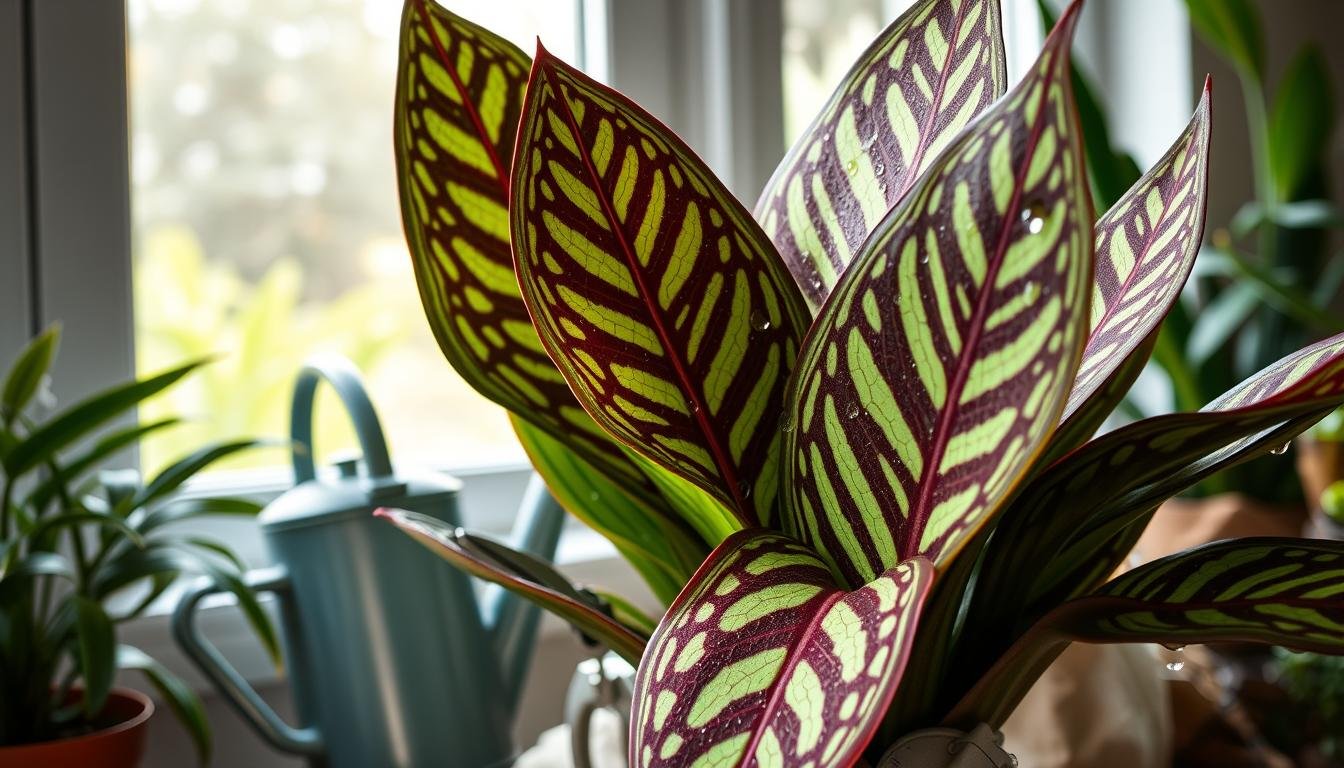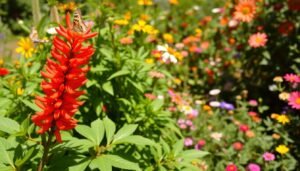The rattlesnake plant, known as Goeppertia insignis, is a stunning tropical evergreen. It adds exotic beauty to your indoor plants. Native to Brazil, it’s loved for its unique foliage with eye-catching patterns and deep purple undersides.
Understanding its care is key to keeping it vibrant and thriving at home. You’ll need to consider light, moisture, temperature, and humidity. With the right knowledge, it can become a stunning centerpiece in your home.
Starting this gardening journey brings you closer to creating a jungle oasis at home. For more tips on keeping your plants healthy, check out more gardening tips.
Key Takeaways
- The rattlesnake plant thrives in bright, indirect light and can grow up to 20 inches indoors.
- Regular care includes maintaining moisture in well-draining soil and understanding seasonal watering needs.
- This tropical foliage requires consistent humidity levels to flourish.
- Monthly fertilization during growth seasons helps to promote healthy foliage.
- Recognizing and managing common pests will keep your rattlesnake plant in optimal health.
- Propagation through division is the simplest method for expanding your plant collection.
Introduction to the Rattlesnake Plant
The rattlesnake plant is a stunning choice for tropical plants. It catches the eye with its beautiful foliage and wavy leaves. Known scientifically as Calathea lancifolia, it loves indoor spaces because it’s easy to care for.
Its leaves look like a rattlesnake’s skin, adding to its charm. This makes it a standout in any room.
For those wanting to grow a rattlesnake plant, knowing how to care for it is key. It thrives in warm, humid places, like Brazilian rainforests. The best temperature is between 65 to 80°F (18 to 27°C). Humidity should be at least 50%.
Adding a rattlesnake plant to your home has many perks. It purifies the air and makes your space look better. It also brings positive vibes to your home. Learning about this plant will make your gardening journey more rewarding.
Understanding the Rattlesnake Plant’s Botanical Background
The rattlesnake plant, known scientifically as Goeppertia insignis, is part of a fascinating group of plants. Its scientific name tells us about its place in the plant world. It also shows its importance in nature. Knowing about these details helps us appreciate this unique plant more.
Scientific Classification and Common Names
The scientific name of the rattlesnake plant is as follows:
| Category | Details |
|---|---|
| Kingdom | Plantae |
| Order | Zingiberales |
| Family | Marantaceae |
| Genus | Goeppertia |
| Species | insignis |
This plant is also known as the rattlesnake plant, prayer plant, or rattlesnake calathea. It was once called a Calathea, but now it’s in the Goeppertia genus.
Native Habitat and Growth Characteristics
The rattlesnake plant comes from the rainforests of Brazil. It loves humid, shaded places. Indoors, it can grow up to 1.5 feet tall, and outdoors, it can reach 2.5 feet.
Its leaves can grow up to 18 inches long. This shows off its beautiful leaves.
When grown outdoors, it sometimes blooms with yellow flowers in late spring. But indoors, it rarely flowers. It’s mainly grown for its looks. It needs regular watering from April to August to keep the soil moist. But too much sunlight can burn its leaves.
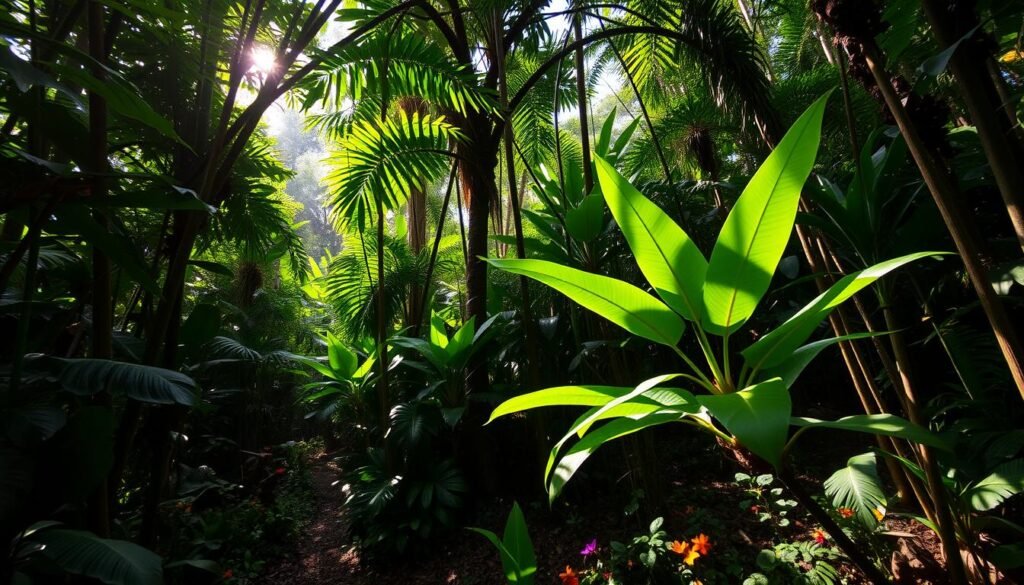
Key Care Requirements for Your Rattlesnake Plant
Caring for your rattlesnake plant is important for its health. You need to know about the best light, soil, and watering. These steps help keep your plant happy and thriving at home.
Optimal Light Conditions
Your rattlesnake plant loves bright, indirect light. Place it near east or north windows. This light is gentle, just like its natural home. Make sure the light is between 200 and 800 foot-candles.
If you use grow lights, keep them 12 to 24 inches away. This prevents the leaves from getting too hot.
Proper Soil Mixture
Choosing the right soil is key. You want a mix that holds moisture but drains well. Mix two parts peat moss, one part perlite, and some compost.
Keep the soil pH between 6.0 and 7.0. This helps your plant grow well.
Watering Guidelines
Watering is important. Water your plant every 1-2 weeks. Let the top inch of soil dry out before watering again. This keeps the soil moist but not too wet.
Check the soil often to avoid overwatering. Yellow leaves can mean too much water. For more on watering, see here.
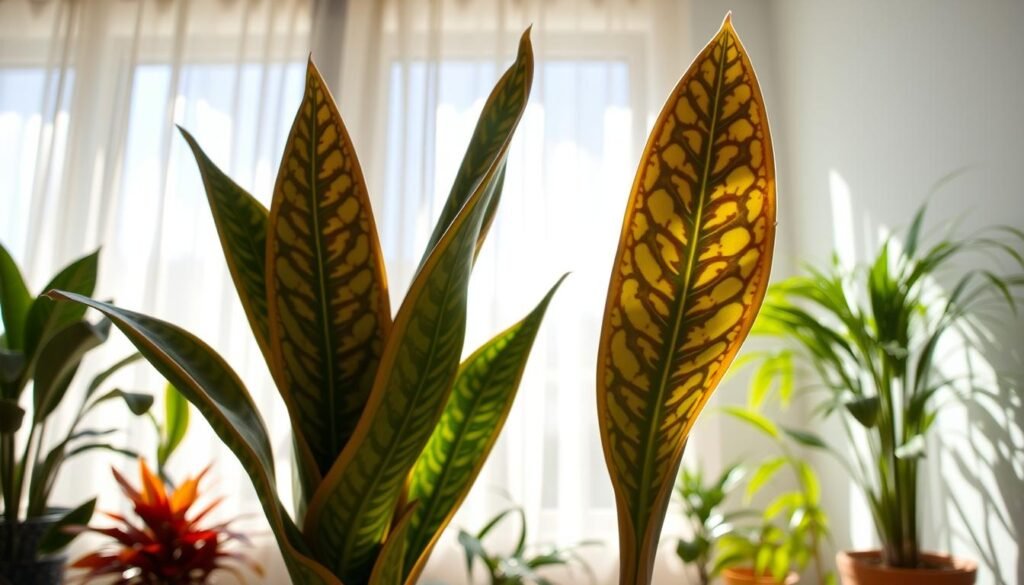
| Care Aspect | Optimal Range |
|---|---|
| Light Conditions | 200 – 800 foot-candles |
| Soil pH Level | 6.0 – 7.0 |
| Watering Frequency | Every 1-2 weeks |
| Humidity Levels | 50% – 70% |
| Temperature Range | 60°F – 75°F |
By following these care tips, your rattlesnake plant will thrive. It will add beauty and fresh air to your home.
Temperature and Humidity Needs
Knowing the right temperature and humidity for your rattlesnake plant is key. This plant loves specific conditions that mimic its natural home. The right temperature and humidity are essential for a healthy plant.
Ideal Temperature Range
The rattlesnake plant does best in temperatures between 65°F and 80°F. This range helps it grow strong and healthy. Avoid cold or drafts, as they can harm your plant.
Keeping your plant warm in cold months is important. Also, try to avoid sudden changes in temperature. These can stress your plant.
Maintaining Humidity Levels
High humidity is important for your rattlesnake plant. It should be between 50% and 60%. This helps it grow well and might even bloom indoors.
To keep humidity right, you can mist the leaves or use a humidifier. You can also put a pebble tray with water near the plant. Grouping plants together can also help keep the air moist.
Remember to adjust humidity levels with the seasons. Increase it in spring, keep it high in summer, and lower it in fall. If it gets too dry, your plant might show signs like browning leaves.
By focusing on humidity and temperature, you can keep your rattlesnake plant happy and healthy.
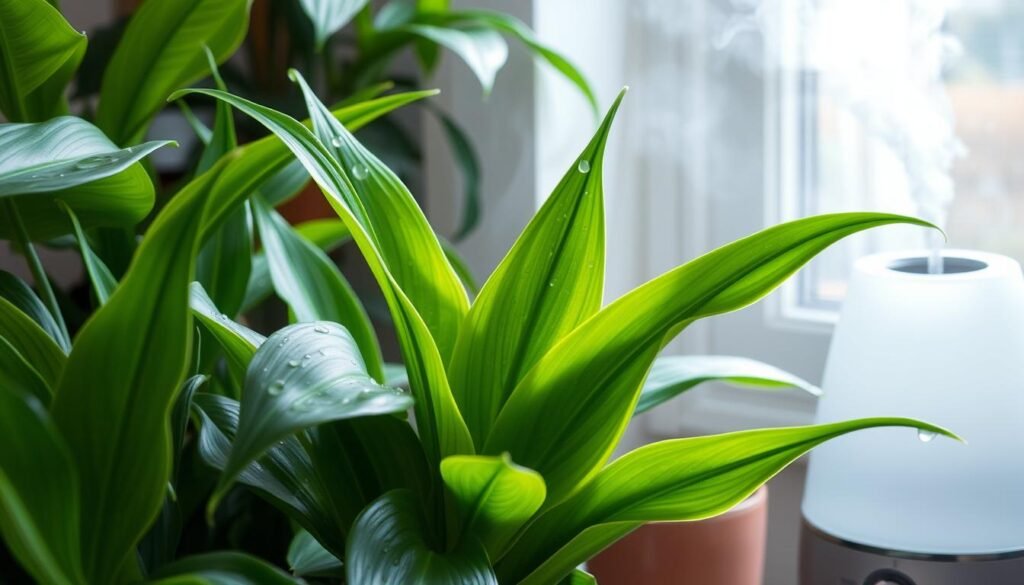
| Humidity Level | Effects on Rattlesnake Plant |
|---|---|
| Below 50% | Causes browning leaf tips and crispy leaves. |
| 50% – 60% | Ideal for healthy growth and possible flowering. |
| Above 70% | May cause too much moisture, attracting pests. |
How to Fertilize Your Rattlesnake Plant
Fertilizing your rattlesnake plant is key to its health and growth. Spring and summer are the best times to fertilize. Use a balanced fertilizer with a 10-10-10 NPK ratio. This mix of nitrogen, phosphorus, and potassium is essential for your plant’s development.
Feed your rattlesnake plant once a month. Dilute liquid fertilizer to half strength to avoid burning the leaves. Watch for signs that your plant needs more nutrients, like slow growth or no blooms.
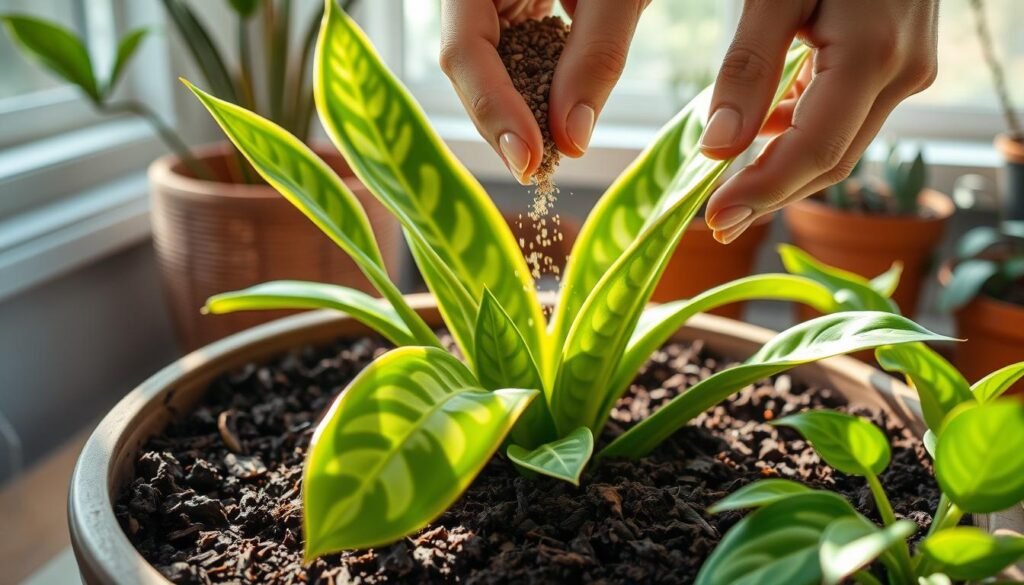
Be careful not to over-fertilize. Yellow or brown leaves, wilting, and brown spots are signs of too much fertilizer. If this happens, use a balanced fertilizer or flush the soil to remove excess nutrients. When your plant is blooming, use a fertilizer higher in phosphorus but less often.
Both liquid and granular fertilizers work well. Use rain, distilled, or filtered water for better results. Make sure the soil is well-drained and rich in organic material for your plant’s health.
| Type of Fertilizer | Frequency | Application Method |
|---|---|---|
| Liquid Fertilizer | Once a month | Mixed with water |
| Granular Fertilizer | Once a month | Sprinkled on soil surface |
| Organic Fertilizer | Once every 2-3 months | Mixed into soil |
By following these fertilization tips, your rattlesnake plant will flourish. It will have vibrant leaves and beautiful blooms. Keep an eye on your plant to adjust its nutrition needs.
Common Problems and Solutions
Rattlesnake plants can face many issues that affect their health. Keeping a close eye on your plants helps solve these problems quickly. Two big concerns are pest management and spotting environmental stress signs.
Pest Management
Keeping pests away is key to your rattlesnake plant’s health. Pests like spider mites, aphids, and mealybugs can harm your plants fast. Use insecticidal soap or neem oil to fight these pests. They are safe and work well.
Check the undersides of leaves often. This helps catch pests early, making treatment more effective.
Identifying Environmental Stress Symptoms
Spotting stress signs in your rattlesnake plant is important for its health. Signs include leaf curl, yellowing, or browning edges. These often come from wrong watering, low humidity, or too much sun.
Keep humidity between 50% and 70% to avoid these problems. This helps your plant grow well. For more info on common issues and solutions, check out this resource.
Propagating Your Rattlesnake Plant
To successfully propagate your rattlesnake plant, the division method is the best choice. Early spring is the best time to do this when the plant is growing well. This method lets you split the root ball into sections, each with healthy roots and stems. This way, you can share plants with other gardeners.
Division Method Explained
When you divide your rattlesnake plant, you help it grow and stay healthy. Here’s how to do it right:
- Prepare the plant: Gently remove the rattlesnake plant from its pot.
- Inspect the root ball: Look for natural divisions in the roots.
- Divide the roots: Using sterilized tools, separate the root ball into equal sections, making sure each division has roots and stems.
- Replant: Position each section in suitable soil mixtures, improving growth chances.
- Water thoroughly: Make sure each new plant has enough moisture.
Using a mix of coarse sand, potting soil, and vermiculite is good for replanting. After you propagate, watch your plants closely. Look for signs of success like new growth, vibrant leaves, and strong roots.
If you see yellow leaves or wilting, act fast. Regular care helps you spot and fix problems. For more tips, check out this useful resource.
| Step | Action | Notes |
|---|---|---|
| 1 | Prepare the plant | Gently take out the plant from its pot |
| 2 | Inspect the root ball | Identify natural divisions in roots |
| 3 | Divide the roots | Use sterilized tools to separate sections |
| 4 | Replant | Use appropriate soil mixtures for each section |
| 5 | Water thoroughly | Ensure consistent moisture for root establishment |
Choosing the Right Container for Your Rattlesnake Plant
Choosing the right container is key for your Rattlesnake Plant’s health and growth. The right container selection gives the plant enough space, moisture, and air for its roots. Make sure the pot has drainage holes to avoid water pooling, which can cause root rot.
Rattlesnake Plants, or Calathea lancifolia, do best in containers that drain well. Different materials work well, such as:
- Ceramic Pots: Great for keeping moisture in and are good for humidity.
- Terracotta Pots: Let excess moisture evaporate, preventing soggy soil.
- Plastic Pots: Light, affordable, and good for beginners, but less breathable.
- Metal Pots: Stylish, but make sure they have holes for drainage.
Size is important when picking a new container. A pot 2 inches larger than the current one supports healthy roots. For more tips, check out this guide.
Good drainage is vital for Rattlesnake Plants, as they like well-draining soil. Clean the new pot well before repotting to avoid risks from old residues. Choose a mix that holds some moisture but lets excess water out.
By choosing the right container, you create a great environment for your Rattlesnake Plant. Follow these tips to help your plant not just survive but flourish in its new home.
Decorative Uses of the Rattlesnake Plant in Your Home
The rattlesnake plant is known for its striking look. It can be a focal point in any room. Adding it to your space can turn it into a green oasis.
Pair it with other plants to make your home look lush. This will enhance your living area.
Styling Tips for Indoor Spaces
Here are some tips to use your rattlesnake plant:
- Put it in a bright, indirect light spot to show off its patterns.
- Choose decorative pots that match your decor for a nice look.
- Group it with plants that need the same care for a nice look.
- Put it on bookcases or shelves for a vertical garden effect.
Companion Planting Ideas
The rattlesnake plant looks great with ferns and other Calathea species. These plants not only look good together but also need the same care. They do well in similar humidity and indirect light.
Planting them together creates a beautiful jungle look in your home. It also improves the air quality. For more on the rattlesnake plant’s benefits, check this link.
Conclusion
The rattlesnake plant is not just beautiful. It also makes your indoor garden better. To keep it healthy, make sure it gets the right light, water, and temperature. This way, it can grow up to 30 inches tall.
It loves indirect sunlight, best when it’s three feet from a window. Water it right, letting the soil dry between waterings. If you see yellow leaves, it might be too wet or lacking nutrients.
By taking care of your rattlesnake plant, you make your home greener. You can even grow more by dividing it. With these tips, you’re ready to grow a stunning rattlesnake plant indoors.

